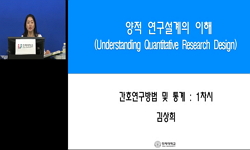Qualitative research provides useful insights with which to analyze the User Experience (UX). This is distinguished from quantitative research by its inductive form of logic and the research aim of understanding holistic phenomena. Since qualitative r...
http://chineseinput.net/에서 pinyin(병음)방식으로 중국어를 변환할 수 있습니다.
변환된 중국어를 복사하여 사용하시면 됩니다.
- 中文 을 입력하시려면 zhongwen을 입력하시고 space를누르시면됩니다.
- 北京 을 입력하시려면 beijing을 입력하시고 space를 누르시면 됩니다.
A semantic network analysis as a method for understanding qualitative user experience in product interactions
한글로보기https://www.riss.kr/link?id=T14619833
- 저자
-
발행사항
서울 : 서울대학교 대학원, 2017
-
학위논문사항
학위논문(박사) -- 서울대학교 대학원 , 산업·조선공학부 인간공학전공 , 2017. 8
-
발행연도
2017
-
작성언어
영어
- 주제어
-
DDC
623.8 판사항(22)
-
발행국(도시)
서울
-
기타서명
제품 상호작용 시 정성적 사용자 경험 이해를 위한 의미망 분석 방법
-
형태사항
x, 165 p. : 삽화 ; 26 cm
-
일반주기명
참고문헌 수록
- DOI식별코드
- 소장기관
-
0
상세조회 -
0
다운로드
부가정보
다국어 초록 (Multilingual Abstract)
First, the representativeness of sample size was examined by observing the stability of a semantic network. Among the semantic networks generated from the text, subnetworks were sampled from the original network to vary the sample size. Then, similarities between subnetworks and the original were calculated by applying correlation analysis to node-level centralities. Three case studies that were composed of two interview datasets and one online review data were presented; these proved that this method could be applicable for both small and large samples.
Second, a mixed-method research approach was introduced to suggest appropriate camera shutter press sounds. In qualitative research, important UVs were elicited by analyzing terms with high centralities in a semantic network. The elicited UVs were then used as questionnaire items in quantitative research to represent UV with numerical values. The result demonstrated user satisfaction models for shutter press sounds and the relationships between UV and PA by adopting the concept of psychoacoustic variables.
Third, the importance of UV and their relations to PA were examined based on qualitative research on vacuum cleaners. Seven types of network centrality were used to weight the UVs, which resulted in UX quantification models. These models’ goodness-of-fit were compared to the results of quantitative research. Then, the links between UV and PA nodes were identified. Since statistical analysis without a proper theoretical interpretation may mislead users, qualitative data can assist quantitative research by examining the sematic associations between UV and PA.
Compared to traditional qualitative studies, the proposed method in this dissertation has a competitive edge for reducing the cost, effort, and subjectivity. Determining the smallest sample size that can achieve network stability is a novel data collection strategy that attempts to maximize effectiveness while minimizing both cost and effort. Utilizing this method allows UX researchers and practitioners to collect the optimal sample size by gradually increasing their sample sizes. Important UVs were elicited in the process of evaluating UX, and their importance was quantified to build a UX quantification model. Transferring qualitative descriptions to the quantitative models allows researchers to understand UX more efficiently by reducing the process of collecting numerical data on each UV. Lastly, important PA and their relations to UV were identified. Although centrality measures were not proportional to the correlation level, semantic associations between UV and PA could be identified. Considering that huge amounts of text data are being generated and collected every day, the suggested method is expected to be useful for practical applications when developing products.
Qualitative research provides useful insights with which to analyze the User Experience (UX). This is distinguished from quantitative research by its inductive form of logic and the research aim of understanding holistic phenomena. Since qualitative research aims to identify intangible factors and explore phenomena without simplifying contextual information, it is difficult to exclude a researcher’s subjectivity during their analysis. In addition, interpreting and analyzing qualitative materials requires much time and effort. Therefore, this dissertation suggests a systematic research method that utilizes user expression data to understand UX. The research starts by transforming textual data into numerical representations using semantic network analysis; three major issues were elucidated from the limitations of existing methods: (1) examining the representativeness of the sample size, (2) eliciting important user values (UV), and (3) evaluating product attributes (PA) with numerical inferences.
First, the representativeness of sample size was examined by observing the stability of a semantic network. Among the semantic networks generated from the text, subnetworks were sampled from the original network to vary the sample size. Then, similarities between subnetworks and the original were calculated by applying correlation analysis to node-level centralities. Three case studies that were composed of two interview datasets and one online review data were presented; these proved that this method could be applicable for both small and large samples.
Second, a mixed-method research approach was introduced to suggest appropriate camera shutter press sounds. In qualitative research, important UVs were elicited by analyzing terms with high centralities in a semantic network. The elicited UVs were then used as questionnaire items in quantitative research to represent UV with numerical values. The result demonstrated user satisfaction models for shutter press sounds and the relationships between UV and PA by adopting the concept of psychoacoustic variables.
Third, the importance of UV and their relations to PA were examined based on qualitative research on vacuum cleaners. Seven types of network centrality were used to weight the UVs, which resulted in UX quantification models. These models’ goodness-of-fit were compared to the results of quantitative research. Then, the links between UV and PA nodes were identified. Since statistical analysis without a proper theoretical interpretation may mislead users, qualitative data can assist quantitative research by examining the sematic associations between UV and PA.
Compared to traditional qualitative studies, the proposed method in this dissertation has a competitive edge for reducing the cost, effort, and subjectivity. Determining the smallest sample size that can achieve network stability is a novel data collection strategy that attempts to maximize effectiveness while minimizing both cost and effort. Utilizing this method allows UX researchers and practitioners to collect the optimal sample size by gradually increasing their sample sizes. Important UVs were elicited in the process of evaluating UX, and their importance was quantified to build a UX quantification model. Transferring qualitative descriptions to the quantitative models allows researchers to understand UX more efficiently by reducing the process of collecting numerical data on each UV. Lastly, important PA and their relations to UV were identified. Although centrality measures were not proportional to the correlation level, semantic associations between UV and PA could be identified. Considering that huge amounts of text data are being generated and collected every day, the suggested method is expected to be useful for practical applications when developing products.
목차 (Table of Contents)
- CHAPTER 1. Introduction 1
- 1.1. Background and motivation 1
- 1.2. Research objective 6
- 1.2.1. Examine representativeness 7
- 1.2.2. Identify user values (UV) 7
- CHAPTER 1. Introduction 1
- 1.1. Background and motivation 1
- 1.2. Research objective 6
- 1.2.1. Examine representativeness 7
- 1.2.2. Identify user values (UV) 7
- 1.2.3. Relate product attributes (PA) 8
- 1.3. Dissertation outline 9
- CHAPTER 2. Literature Review 11
- 2.1. Semantic network analysis 11
- 2.1.1. Definition 11
- 2.1.2. Co-occurrence 12
- 2.1.3. Network statistics 14
- 2.2. Sample size 19
- 2.2.1. Reliability of qualitative text data 19
- 2.2.2. Sample size of HCI studies 20
- 2.3. User experience (UX) evaluation techniques 22
- 2.3.1. User value 22
- 2.3.2. Quantification model 23
- 2.4. Product design 25
- 2.4.1. User-Centered Design (UCD) 25
- 2.4.2. Design method 26
- CHAPTER 3. Evaluating Representativeness of Unstructured Text Data 29
- 3.1. Overview 29
- 3.2. Method 31
- 3.2.1. Datasets 31
- 3.2.2. Research process 33
- 3.3. Results 40
- 3.3.1. Descriptive statistics and network-level statistics 40
- 3.3.2. Number of resampling 44
- 3.3.3. Network stability analysis 45
- 3.3.4. Relationship between network characteristics and stability 49
- 3.4. Discussion 52
- CHAPTER 4. Identifying User Values using Qualitative Data for Camera Shutter Sounds 57
- 4.1. Overview 57
- 4.2. Measure 59
- 4.2.1. Loudness (N) 61
- 4.2.2. Sharpness A (S(A)), Sharpness Z (S(Z)) 62
- 4.2.3. Roughness (R) 63
- 4.3. Research process 65
- 4.3.1. Eliciting PA of camera shutter sounds 66
- 4.3.2. Conducting jury test on existing camera shutter sounds 67
- 4.3.3. Eliciting important UVs 67
- 4.3.4. Evaluating effective PAs 68
- 4.3.5. Modifying camera shutter sound 69
- 4.3.6. Conducting jury test on modified shutter sounds 71
- 4.4. Results 72
- 4.4.1. User values (UV) 72
- 4.4.2. User group identification 74
- 4.4.3. Psychoacoustic analysis of sound samples 75
- 4.4.4. Regression model of user satisfaction 76
- 4.4.5. Effect of psychoacoustic variables on UV 77
- 4.4.6. Effect of PA on psychoacoustic variable 80
- 4.5. Discussion 80
- CHAPTER 5. Identifying User Values and Product Attributes using Qualitative Data on Vacuum Cleaners 87
- 5.1. Overview 87
- 5.2. Method 91
- 5.2.1. Eliciting important UV and PA 93
- 5.2.2. Suggesting UX quantification model 95
- 5.2.3. Identifying relevant UV to PA 97
- 5.3. Results 100
- 5.3.1. Important UVs 100
- 5.3.2. UX quantification model 104
- 5.3.3. Relationship between UV and PA 109
- 5.3.4. The role of centrality measures 116
- 5.4. Discussion 118
- CHAPTER 6. Conclusion and Discussion 121
- 6.1. Summary of findings 121
- 6.2. Practical implications of the research 123
- 6.3. Limitations and future research 124
- BIBLIOGRAPHY 127
- APPENDIX A 151
- APPENDIX B 154
- ABSTRACT (in Korean) 162












